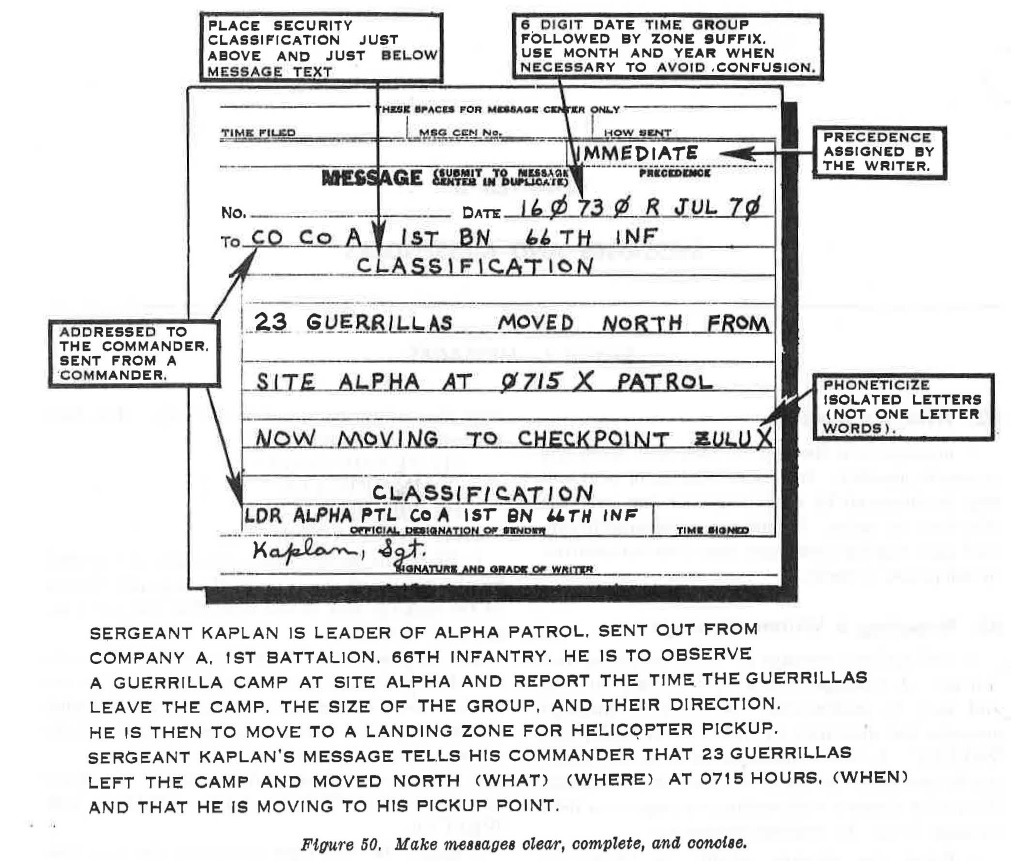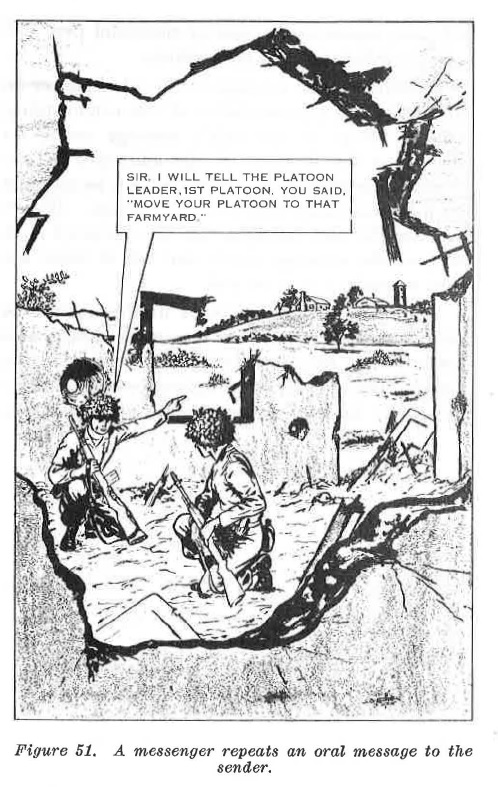Donate
| SECTION I | ---------------------------------- | MESSAGES |
| SECTION II | ---------------------------------- | MESSENGERS |
62. What Is a Message
A message is a thought or idea sent from one person to another. It may be written or oral and may be delivered by a messenger or sent over the telephone or radio. Sometimes a message is carried part way by messenger and then transmitted by telephone or radio.
63. Preparing a Written Message
A well-written message is clear, complete, and concise. A message is clear if it is easy to read and easy to understand. A complete message answers the questions of WHAT, WHEN, and WHERE. A concise message contains only those words necessary to make it clear and complete. Figure 50 shows a well-written message on a field message form. In writing messages.
a. Print the message plainly in block-type letters. Isolated letters ( except single letter words and the letter X when used as punctuation in the text of a message) are spelled out using the phonetic alphabet. For example, the letter Z is spelled out ZULU in figure 50.
b. Use only authorized abbreviations. Do not use an abbreviation unless you are sure it is cor. rect and that it will be understood by the person receiving the message.
c. Always address a message to a commander.
d. Always show the commander by whose authority the message is sent (see OFFICIAL DESIGNATION OF SENDER line in fig. 50).
e. Assign a precedence according to importance of your message in relation to the overall tactical situation. The precedence you assign to the message determines its speed of delivery. The four precedences (speeds) are-
(1) FLASH (fastest)
(2) IMMEDIATE.
(3) PRIORITY.
(4) ROUTINE (slowest)
f. Place the security classification, if required by the nature of the text, at the top and bottom of the message just before and after the text (fig. 50).
g. Use punctuation only if necessary to insure that the meaning of the text is clear. Use the letter X as a symbol for any punctuation needed by drawing it so that it touches the lines of the message form (fig. 50).
h. Sign your name and grade in the space labeled SIGNATURE AND GRADE OF WRITER.
i. Enter the date-time group on the date line immediately after signing the message. The first two digits are the day of the month. The last four digits are the time, expressed in the 24-hour clock system. The last element of the date-time group is the letter identifying the time zone of your area. For example, the date-time group of a message written ltt Fort Benning, Georgia (time zone R), at 23 minutes after 7 o'clock in the morning of 16 July 1970 is: 160723R JUL 70 (fig. 50).
j. Reread your message carefully. When possible, have someone check to see that it is easily read and understood and that it answers the questions vVHAT, WHEN, and WHERE.
k. Destroy the sheet of carbon pa per by burn - ing. When burning is not possible, tear the carbon paper into shreds and scatter them.

Figure 50. Make messages plain, clear and concise.
<-- --------------------------------------------------------------------------- --> <-- ------------------------------ SECTION II -------------------------------- --> <-- --------------------------------------------------------------------------- --> SECTION II. MESSANGERS.
64. Why Messengers Are Important
Messengers are very important in lower units. They are the only means available for sending maps and overlays. Messengers are selected £or their intelligence, trustworthiness, and self reliance. They are needed and used by all units from the smallest to the largest.
65. Equipment
Some units have personnel whose primary duty is to carry messages. However, you may be selected as a messenger because you are specially suited for a particular mission. Your compass and your individual weapon are standard equipment.
Other essential equipment is provided by the person who sends you out.
66. Training
a. When assigned duty as a messenger, you must know how to-
(1) Deliver oral and written messages.
(2) Travel over various kinds of terrain at prescribed rates of speed.
(3) Use a compass for orientation or to follow a given azimuth.
(4) Read maps and orient yourself by stars or the sun.
(5) Select rontes which provide the best cover and concealment consistent with the need for speed.
(6) Recognize commanders and units with which your unit maintains communication.
b. Everyone is a potential messenger, and small unit leaders must insure that each individual receives the necessary training.
67. Double Messengers
Double messengers may be used when the message to be delivered is of vital importance or when the route to be traveled is difficult or exposes the messenger to enemy fire. For details, see FM 7-24.
68. Messenger Briefing
a. When you are given a message to deliver, the dispatching officer or noncommissioned officer should provide the following information:
(1) Name and location of the headquarters or person to whom the message is to be delivered.
(2) Route to follow.
(3) Danger points to avoid.
(4) Speed required.
(5) Whether an answer is required.
(6) Where to report in case the message cannot be delivered
(7) Contents of message, when the situation warrants.
(8) Special instructions, if any.
b. If he does not include this information, be sure to ask for it.
c. The dispatching officer should also instruct you to report your destination to the nearest leader when passing an outpost or position established by a security detachment. This leader will orient and assist you if necessary.
69. What to Do When Carrying Messages
When there is danger of meeting the enemy, travel by covered and concealed routes. If you are to travel over difficult routes at night, reconnoiter them during the day when possible. When you are approaching or leaving command posts, be particularly careful to avoid disclosing the location. Strive to give prompt delivery and to prevent needless exposure. Ask directions from friendly troops you meet. When instructed to show unsealed messages to commanders en route, ask them to sign the message after reading. When in immediate danger of capture, memorize your message and destroy it.

Figure 51. A messenger repeats an oral message to the sender.
70. How to Deliver an Oral Message
a. When time permits, messages are written. Oral messages, however, may often be necessary in fast-moving situations. They are kept short and simple to prevent errors in transmission. When receiving an oral message, repeat it to the sender and then memorize it (fig. 51). Deliver it word for word.
b. At times you may be asked to take a reply or other message for your own unit. This is part of your job unless you have been instructed not to delay your return for any reason.
c. When you cannot find a headquarters, message center, or an addressee without undue loss of time, report to the nearest command post and ask for assistance and instructions.
d. Deliver your message to the addressee or to an authorized representative of the commanding officer. Stop at the unit's message center to determine the location of the addressee or authorized representative; then deliver the message to him personally and obtain a receipt. Before leaving the unit headquarters or command post, stop at the message center and ask if there are any messages for your unit.
e. If your transportation is disabled, continue to your destination in the most practicable manner. It may be advisable to report to the nearest headquarters for assistance and instructions.
If for any reason you are unable to continue on your mission, turn over your messages and instructions to any reliable person you meet. Check to satisfy yourself the person is reliable and ciu1 deliver your message. Keep a record oi the person, time, and place; and at the first opportunity give this information to the sender.
71. Select Your Route with Care
The route over which you are to travel is usually selected by the officer or noncommissioned officer in charge. Plan an alternate route to follow in case your primary route cannot be used. If it is an unfamiliar route, ask for a map or sketch to supplement oral instructions. Take advantage of signs or guides and verify the route by asking questions (para 17).